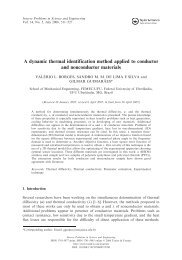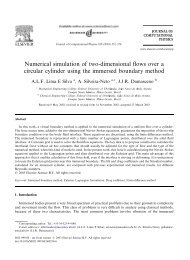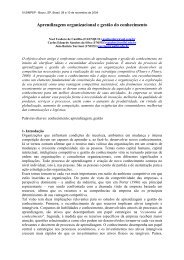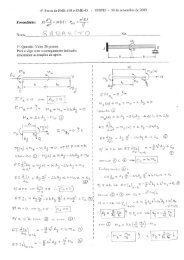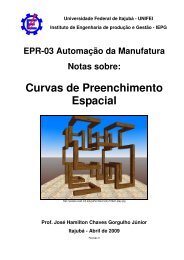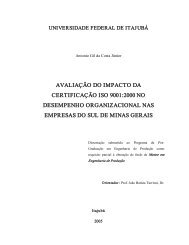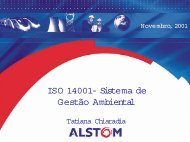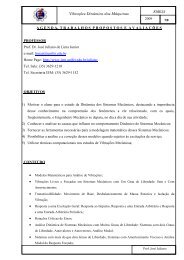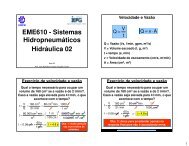Evaluation and analysis of criteria and sub-criteria of a ... - Emerald
Evaluation and analysis of criteria and sub-criteria of a ... - Emerald
Evaluation and analysis of criteria and sub-criteria of a ... - Emerald
Create successful ePaper yourself
Turn your PDF publications into a flip-book with our unique Google optimized e-Paper software.
ECAM15,134assessed in the Questions 2 <strong>and</strong> 3 <strong>of</strong> the questionnaire as to their importance indefining their underlying criterion, <strong>and</strong> their actual effectiveness in the companies <strong>of</strong>the respondents, as can be seen in the Appendix (Figure A1). The <strong>sub</strong>-<strong>criteria</strong> <strong>of</strong> themodel are confirmed in a manner very much similar to that <strong>of</strong> the model <strong>criteria</strong>,through assessing their importance <strong>and</strong> through a factor <strong>analysis</strong> to ensure the singleconstruct structure.Importance <strong>of</strong> <strong>sub</strong>-<strong>criteria</strong> in defining underlying criterionThe results <strong>of</strong> the importance <strong>of</strong> each <strong>sub</strong>-criterion in defining its criterion in the form<strong>of</strong> the means, st<strong>and</strong>ard deviations <strong>and</strong> 5 per cent lower confidence limits werecomputed on an Excel spreadsheet, using its built-in functions in a similar manner tothe model <strong>criteria</strong>. The results show that the mean <strong>and</strong> lower confidence limits <strong>of</strong><strong>sub</strong>-<strong>criteria</strong> were all above average <strong>and</strong> inclined towards the scale maximum <strong>of</strong> fivepoints, hence confirming the importance <strong>of</strong> each <strong>sub</strong>-criterion in defining its underlyingcriterion. Furthermore, the negative skewness <strong>of</strong> these items indicate that even if a few<strong>of</strong> these distributions are not normal, they are nevertheless peaked <strong>and</strong> negativelyconcentrated towards the upper end <strong>of</strong> the scale, as explained with the importance <strong>of</strong>the <strong>criteria</strong> previously. Thus, the actual confidence limits are expected to be higherthan those reported.Factor <strong>analysis</strong> <strong>of</strong> <strong>sub</strong>-<strong>criteria</strong> underlying a criterionThe results <strong>of</strong> the effectiveness assessment <strong>of</strong> each <strong>sub</strong>-criterion were used in factor<strong>analysis</strong> to determine the single factor structure, which was previously conducted inthe discussion <strong>of</strong> the content validity <strong>and</strong> was demonstrated in Table II <strong>and</strong> Figure 3for the Leadership criterion. The factor <strong>analysis</strong> in all other <strong>criteria</strong> showed only onefactor is to be extracted <strong>and</strong> thus confirms the single factor structure assumed in the<strong>criteria</strong> <strong>of</strong> the model.Calculation <strong>of</strong> model criterion weightsThe scoring system <strong>of</strong> the EFQM Excellence Model has been shown to vary acrossindustries <strong>and</strong> has been criticised as not corresponding to the way companies areworking (Eskildsen et al., 2001). Different methods for assessing the actual weights <strong>of</strong>the model’s <strong>criteria</strong> have been reported in literature. For example, Eskildsen et al. (2001)used factor regression coefficients. Cheng <strong>and</strong> Li (2001) used the analytic hierarchyprocess (AHP) to determine the weights <strong>of</strong> performance measures <strong>of</strong> a businessprocess. It is difficult to assess which method is more accurate. Nevertheless, any <strong>of</strong> theempirical approaches mentioned would be preferred to “an arbitrary weight structure,which has never been empirically tested” (Eskildsen et al., 2001, p. 783), as with thecase <strong>of</strong> EFQM. Furthermore, a method that has been previously applied to excellencemodels would be preferred. The factor regression coefficients method was chosen inthis research because it assesses the actual impact <strong>of</strong> each criterion on theorganisation’s performance, whereas with AHP requires expert judgement data thatcan be obtained from the importance rating <strong>of</strong> each criterion, but might affect theaccuracy <strong>of</strong> outcomes in the paired comparisons process, as well as reflecting theimportance perception rather than actual impact.



